Many of the most impressive Greek landmarks date back to Ancient Greece, which was the birthplace of democracy, the cradle of Western civilisation and one of the oldest languages in the world. Home to philosophers, Socrates, Plato and Aristotle, artists and scientists, Greece, is a Mediterranean country rich in history, culture and natural beauty.
Officially called the Hellenic Republic, Greece has been part of the Roman and Ottoman Empires and historic landmarks in Greece date back to the Bronze Age. It’s a producer of marble, olives and feta cheese and home to the Colossus of Rhodes, which was one of the Seven Wonders of the Ancient World. An earthquake destroyed the giant statue of Helios, which inspired the English word “colossal”, straddling the harbour.
Contents
- 20 Greece Landmarks
- Natural Landmarks in Greece
- Historic Landmarks of Greece
- 4- Knossos Palace
- 5- Sanctuary of Delphi
- 6- Parthenon Temple, Acropolis
- 7- Temple of Poseidon
- 8- Ancient Olympia
- 9- Epidaurus Ancient Theatre
- 10- Hagia Sofia
- 11- Mount Athos Monasteries
- 12- The archaeological site of Mystras
- 13- Monasteries of Meteora
- 14- Rhodes Castle
- 15- Bourtzi Fortress
- 16- Mykonos Windmills
- 17- Old Royal Palace
- 18- Academy of Athens
- 19- Shipwreck on Navagio Beach
- 20- Monument of Alexander the Great
20 Greece Landmarks
Natural Landmarks in Greece
1- Caldera of Santorini
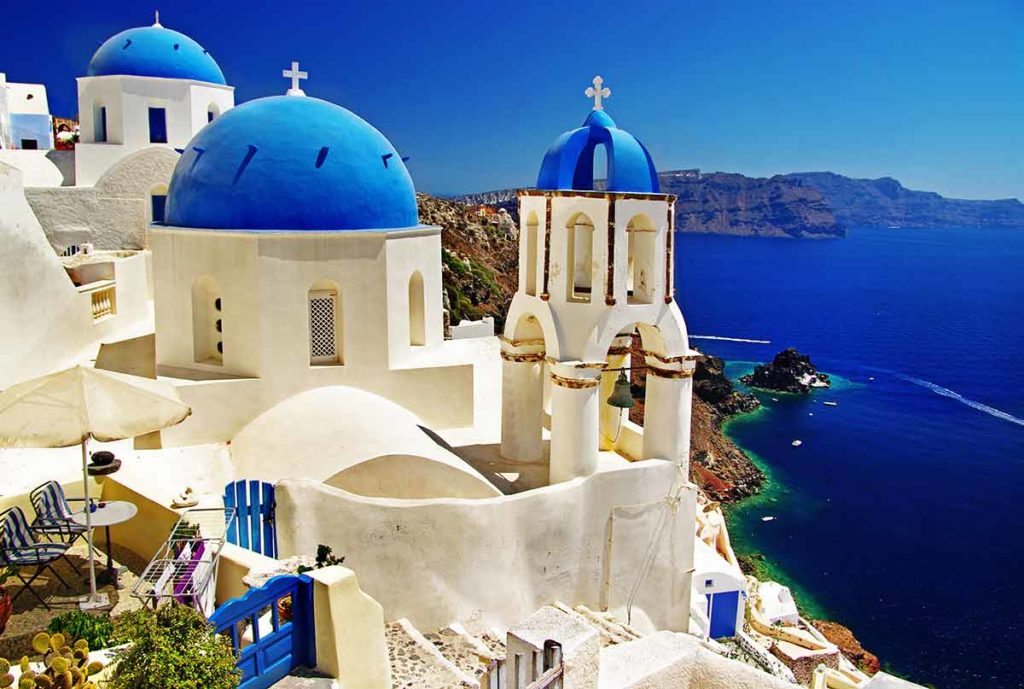
120 km north of Crete, the Santorini Caldera is a submerged caldera in the Aegean Sea formed around 1620 BC (about 3600 years ago).
This natural landmark of Greece is part of a submerged volcano that formed when the volcano at Thira erupted and hot landslides of volcanic material flowed into the sea.
This particular eruption was one of the largest ever experienced throughout history.
It created the Santorini islands with the caldera’s rim being a cliff on the west side of Thera.
The eruption dumped 40 cubic km of pyroclastic flows on the seabed, triggering a tsunami that ultimately caused the Minoan civilisation to collapse.
You can admire the red cliffs of the caldera from many of the eye-catching white villages along the cliffs, including Oia and Imerovigli.
The Santorini volcano is dormant as there has not been an eruption since 1950, but it has erupted 12 times before.
Each time it erupts, it shapes the region around it, creating islands and lagoons.
2- Mount Olympus
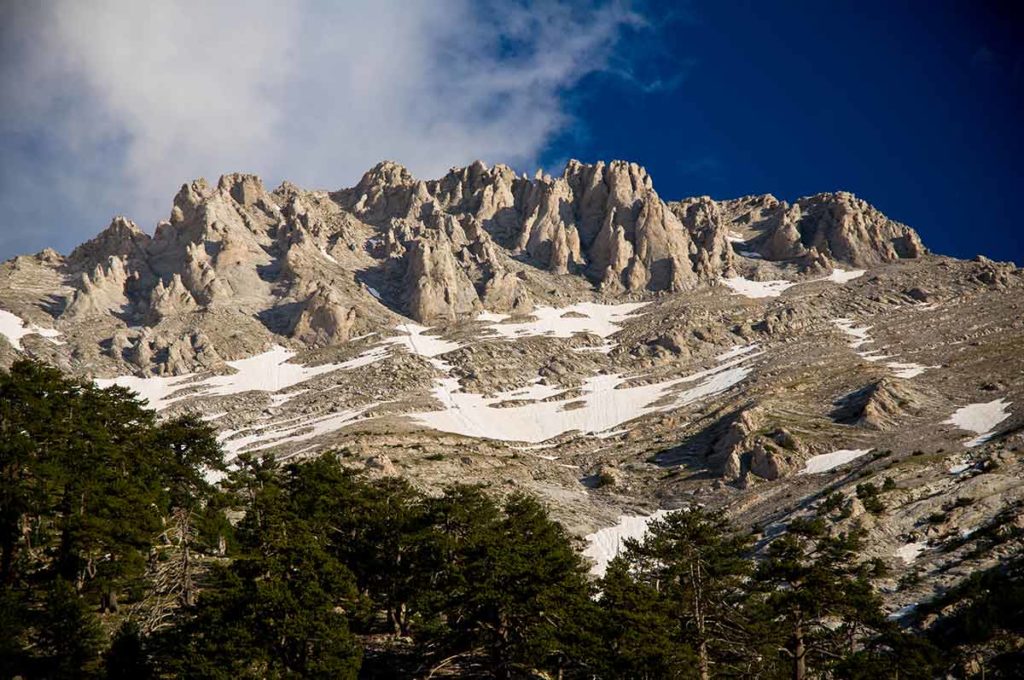
Greece’s highest mountain, Mount Olympus, has 52 peaks and deep gorges.
The highest peak, Mytikas is 2,917 m (9,570 ft) and, according to legend, was the home of the Greek gods.
The mountain is home to Mount Olympus National Park, which is the first National Park in Greece and home to a rich biodiversity of plants.
Visit Mount Olympus from the town of Litochoro in the eastern foothills of the mountain, 100 km (62 miles) from Thessaloniki.
3- Blue Caves
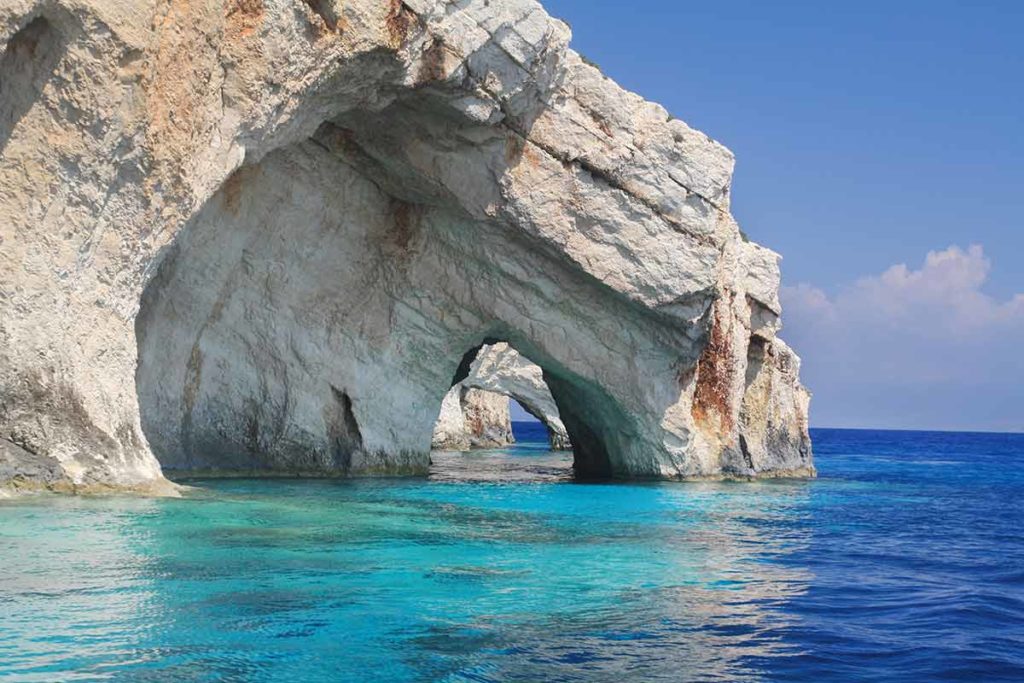
Another of the most famous natural landmarks in Greece is the Blue Caves of Zakynthos.
These natural limestone formations have been worn away by the tide and are an attraction to visit on a boat ride.
As you cruise under the white limestone arches, the reflection of the water casts a blue tinge on the caves.
They were discovered in 1897 but have been shaped by centuries of tides.
The Blue Caves are near Zakynthos in the Ionian Sea and are accessible from Aghios Nikolas Port.
For more amazing European Landmarks, read:
- 30 Spain Landmarks
- 20 Switzerland Landmarks
- 22 Germany Landmarks
- 35 London Landmarks
- 30 France Landmarks
- 20 Italy Landmarks
- 20 Greece Landmarks
- 20 Russia Landmarks
- 20 Scotland Landmarks
- 20 Ireland Landmarks
- 21 Wales Landmarks
- 20 Turkey Landmarks
- 20 England Landmarks
- 20 Hungary Landmarks
- 21 Romania Landmarks
- 20 Ukraine Landmarks
- 20 Athens Landmarks
- 20 Rome Landmarks
- 20 England Landmarks
- 20 Portugal Landmarks
- 20 Poland Landmarks
- 20 Iceland Landmarks
- 20 Bulgaria Landmarks
- 21 Croatia Landmarks
- 20 Bulgaria Landmarks
- 20 Austria Landmarks
- 21 Finland Landmarks
- 20 Sweden Landmarks
- 20 Denmark Landmarks
- 20 Belgium Landmarks
- 20 Netherlands Landmarks
- 20 Barcelona Landmarks
- 21 Czech Republic Landmarks
- 20 Landmarks in Paris
- 20 Landmarks in Liverpool
- 10 Istanbul Landmarks
Historic Landmarks of Greece
4- Knossos Palace
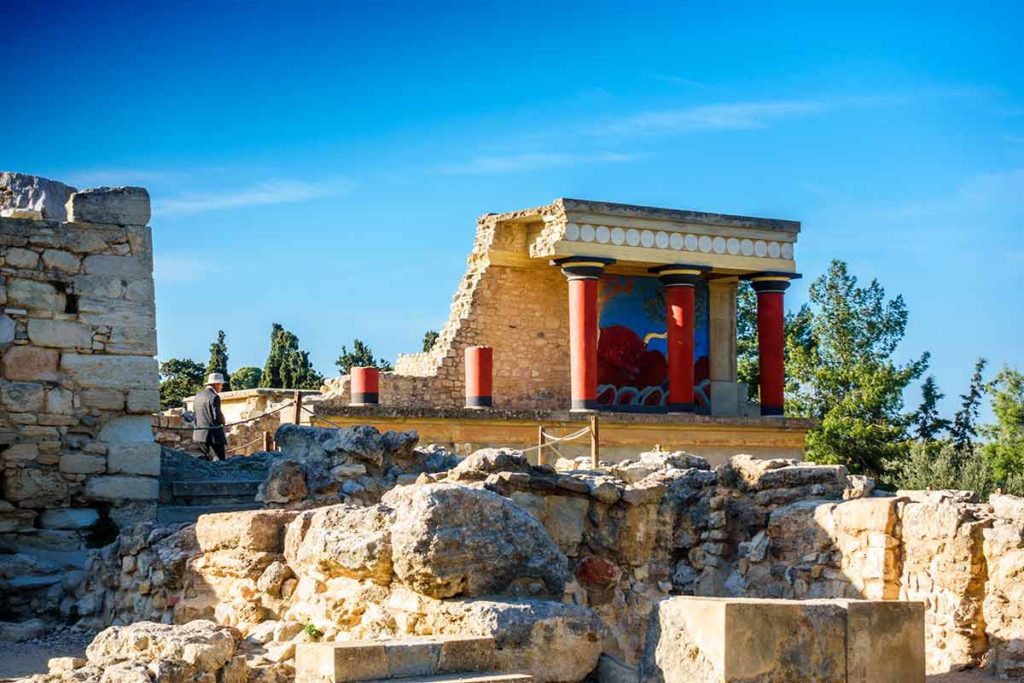
The Minoan civilisation was a civilisation in Crete that flourished during the Bronze Age (around 3000 BC to 1100 BC).
Crete was a trading centre that allowed the Minoans to import luxury items like jewellery and gems while exporting textiles, timber and pottery.
The motifs of Minoan art are the snake, goddess and bull.
Knossos Palace is one of the best landmarks in Greece to delve into Minoan history.
The palace was a hub of power, but although many Minoan structures are called palaces, it’s not clear whether the Minoans had a royal dynasty.
These structures could have been religious buildings or civic centres.
During the 15th century BC, unknown invaders captured the island and overturned the Minoan government.
Even though the civilisation ended, its influence continued to shape the culture of the Mycenaean Greeks and the Cretan Linear B writing system became the basis for the Greek language used by Homer to write The Iliad and The Odyssey.
Knossos Palace is south of Heraklion on the island of Crete.
5- Sanctuary of Delphi
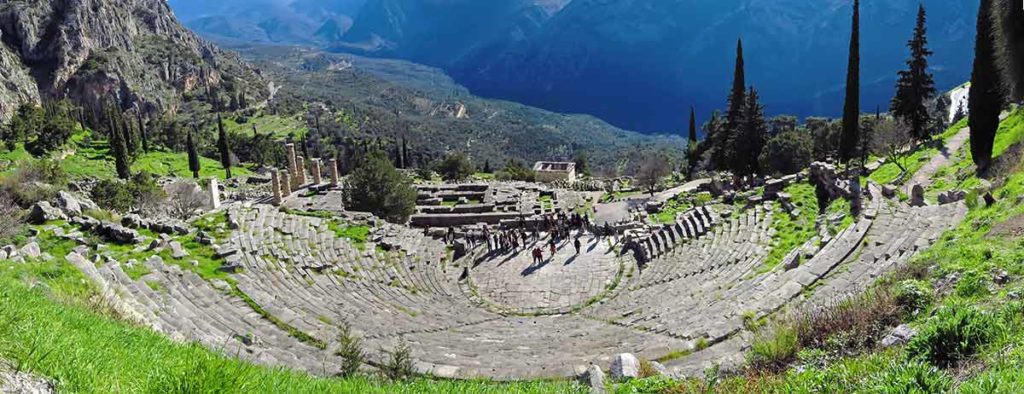
The Sanctuary of Delphi is one of the most famous ancient Greek landmarks.
According to Greek mythology, Delphi was the meeting point of two eagles released by the God of the Sky, Zeus.
A religious and cultural centre of Ancient Greece, Delphi had several important buildings but none as famous as the Temple of Apollo.
The Temple of Apollo (the God of light) was home to the oracle of Apollo, who was a powerful priestess who had the gift of foretelling the future and provided consultation to kings on matters of war.
Built during the 8th century BC, its religious and political influence continued to grow to cult status as the fame of Pythia, the priestess of Apollo, spread far and wide.
Rulers of many regions sent gifts to the Sanctuary to secure favour with the gods.
The temples and terraces of Delphi are located on Mt. Parnassus and is a legacy that testifies to the influence Ancient Greece had on that part of the world.
6- Parthenon Temple, Acropolis
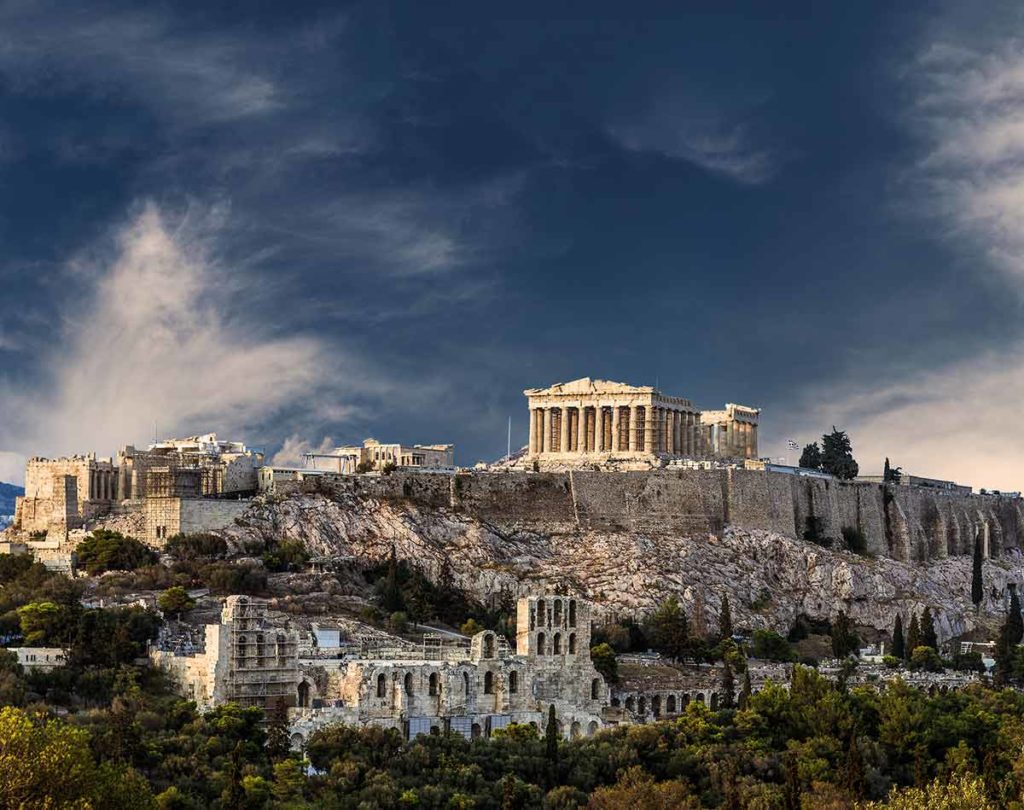
Built in the fifth century BC, Parthenon Temple in the Acropolis in Athens is the most famous landmark in Greece.
This world-renown legacy of Ancient Greece sits on top of a rocky hill gracing the skyline of Athens.
The marble temple was built in the 5th century BC as a tribute to Athena, the Goddess of Wisdom.
The Acropolis is also home to the Temple of Athena Nike and the Theatre of Dionysus and Propylaea.
Wandering around the ancient ruins is an experience that will give you goosebumps and if you want to brush up on history, pop into the New Acropolis Museum at its base.
The Athenian Acropolis inspired Neo-Classical architecture that flourished in Europe.
The golden years of innovation occurred during the reign of Pericles (495 to 429 BC) when creativity in the arts and sciences flourished.
Many of the buildings if the Acropolis were the creation of Ancient Greek sculptor Phidias.
7- Temple of Poseidon
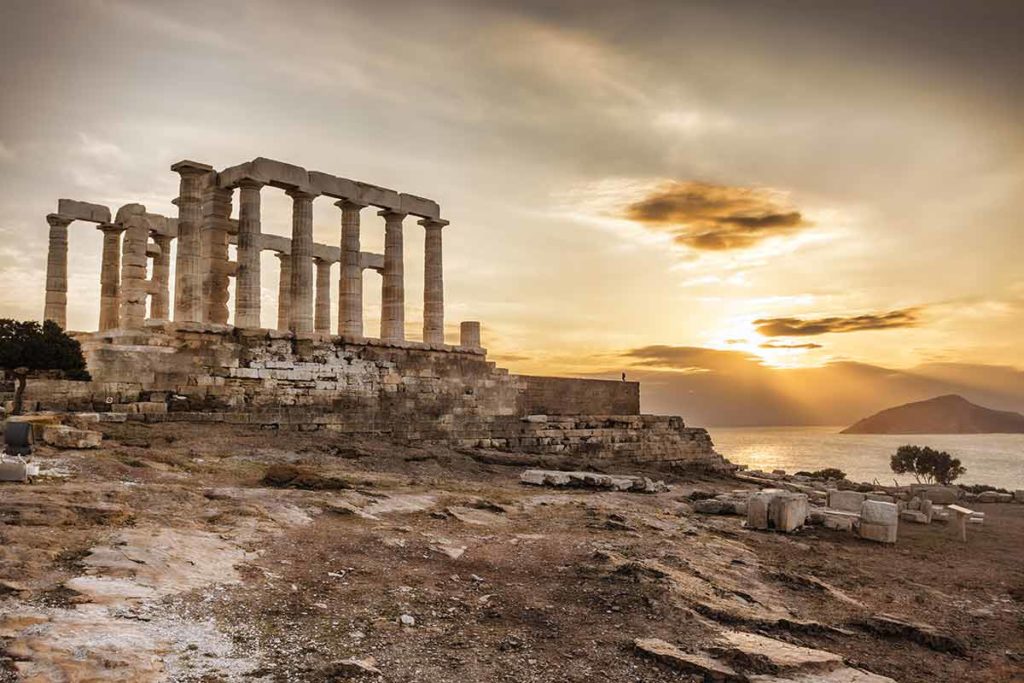
Featured in Homer’s Odyssey, the Temple of Poseidon is an ancient Greek landmark steeped in legends.
Its soaring Doric columns take on a mystical look when the sun’s rays shine between the pillars.
It sits atop Cape Sounion, where Aegeus jumped into the ocean when he spotted the sails on his son’s ship as he had thought that his son Theseus had perished fighting the Minotaur in Knossos.
This legend led to the name of the Aegean Sea, which has inspired writers and poets for centuries including this famous travel quote by Nikos Kazantzakis: “Happy is the man, I thought, who, before dying, has the good fortune to sail the Aegean sea.”
Dedicated to Poseidon, the God of the sea, earthquakes and horses, the temple was constructed around 440 BC.
Over the centuries, the temple has drawn poets and romantics to it, the most famous being Lord Byron.
The poet chiselled his name on a pillar in 1810.
Cape Sounion is a 70 km day trip south of Athens.
8- Ancient Olympia
Ancient Olympia, built around the 4th century BC, is considered one of Greece’s most important archaeological sites and was where the ancient Olympic Games started in 776 BC.
The competition for athletes was in honour of Zeus, the sky god and father of the 12 gods of Olympia.
In 1896, the Olympic Games were revived based on the ideals of the ancient games – peace, justice and progress.
An earthquake buried the buildings in Olympia in the 6th century BC.
They included the Temple of Zeus, which held a massive statue of Zeus that was once considered an ancient seven wonder of the world, gymnasium and stadium.
An explorer rediscovered the ruins in the 18th century.
9- Epidaurus Ancient Theatre
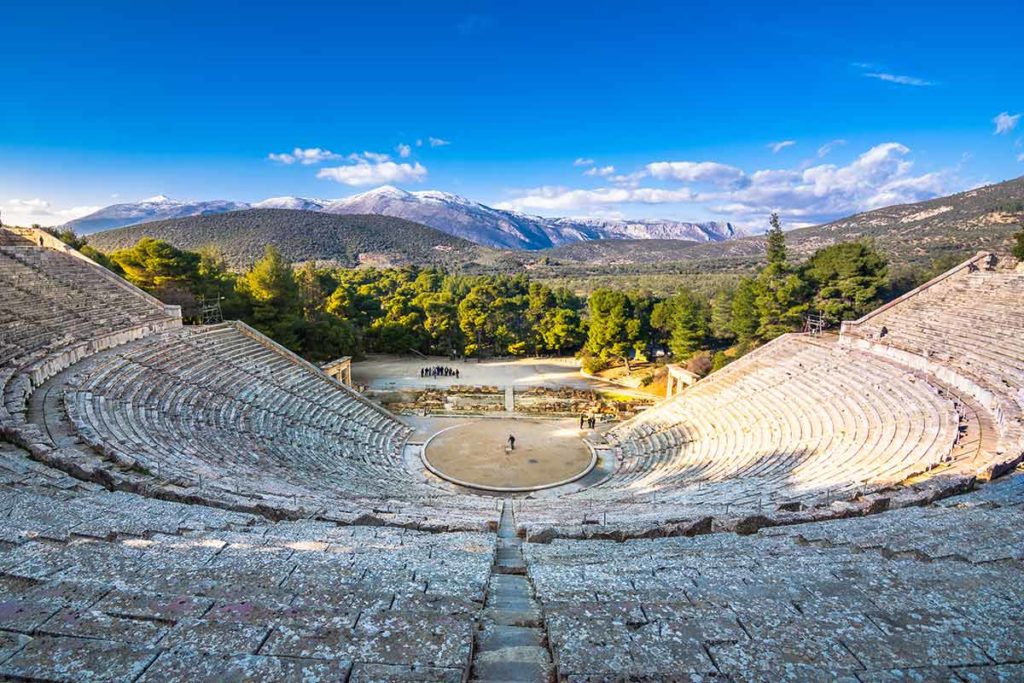
The 4th century BC theatre of Epidaurus is in the eastern Peloponnese and was part of Sanctuary of Asclepius at Epidaurus, a healing centre during ancient times that also had a complex of temples, baths and athletic facilities.
The Epidaurus theatre was built in 340 BC and can fit 13,000 people.
The acoustics were incredibly advanced for its time, allowing spectators in the back rows to hear actors on the stage without using amplification devices.
The reason for the fantastic acoustics is the limestone seats, which could soften low-frequency background noises while reflecting high-frequency sounds from the stage.
Visit during the Epidaurus Festival (in June) to experience this for yourself while watching an Ancient Greek drama.
The Epidaurus Ancient Theatre is a two-hour drive from Athens.
10- Hagia Sofia
Greece’s second-largest city is a place with a long history that dates back to 315 BC.
It was a base for Christianity, so it’s not surprising that Thessalonika has a legacy of Byzantine churches listed as UNESCO World Heritage.
The wall paintings, mosaics and frescoes in Thessalonika’s monuments are masterpieces of Christian art.
Of the many Christian monuments, Hagia Sofia is one of the oldest churches in the city.
The earliest church was built in the 3rd century, however, the current structure was built during the 8th century and modelled after the Hagia Sophia in Istanbul.
Like it’s namesake, this church started as a church and was converted into a mosque when the Ottomans invaded the city.
It became a church again in 1912.
Its domed Basilica temple has beautiful architecture, 11th century AD wall paintings and elaborate mosaics.
11- Mount Athos Monasteries
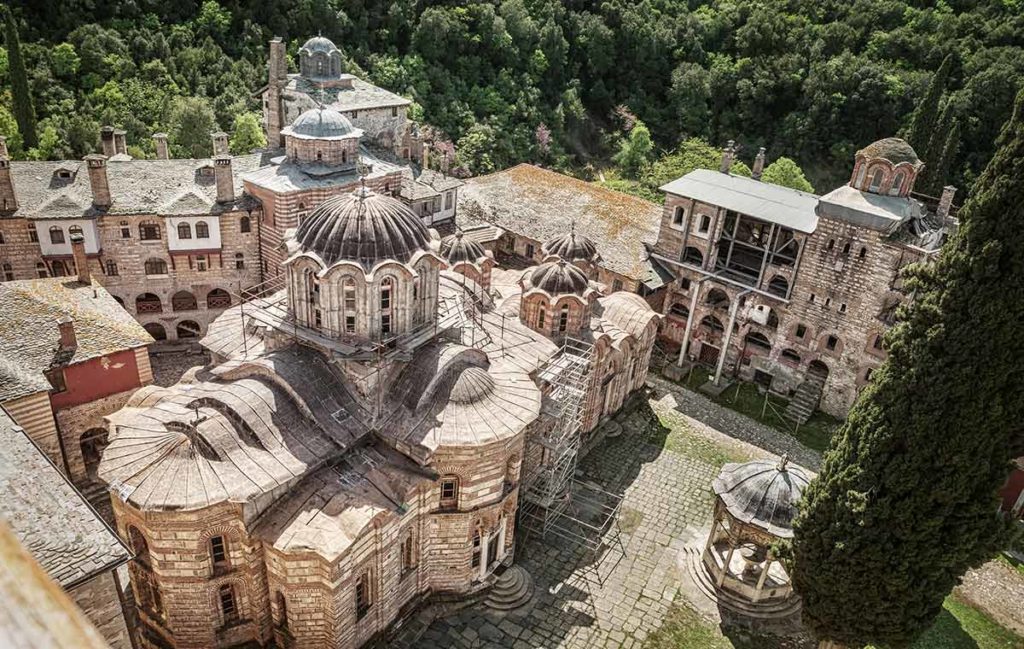
The 20 monasteries of Mount Athos are Greek landmarks of importance in the Orthodox Christian world and the world’s oldest monastic community.
2,000 monks live in these working monasteries, and they follow strict archaic rules and isolated lifestyles that have stayed the same since the ninth century.
To help the monks avoid temptation, women are banned from approaching within 500 m of shore and female animals are not allowed either on Mount Athos.
They grow vegetables, make wine, renovate the monasteries and spend at least six hours a day in prayer.
The monasteries raise funds by selling products, such as herbal teas, wine and olive oil in their gift shops.
Mount Athos is an autonomous self-governed Greek territory on the third peninsula of Halkidiki covering a small area of 330 sq km.
12- The archaeological site of Mystras
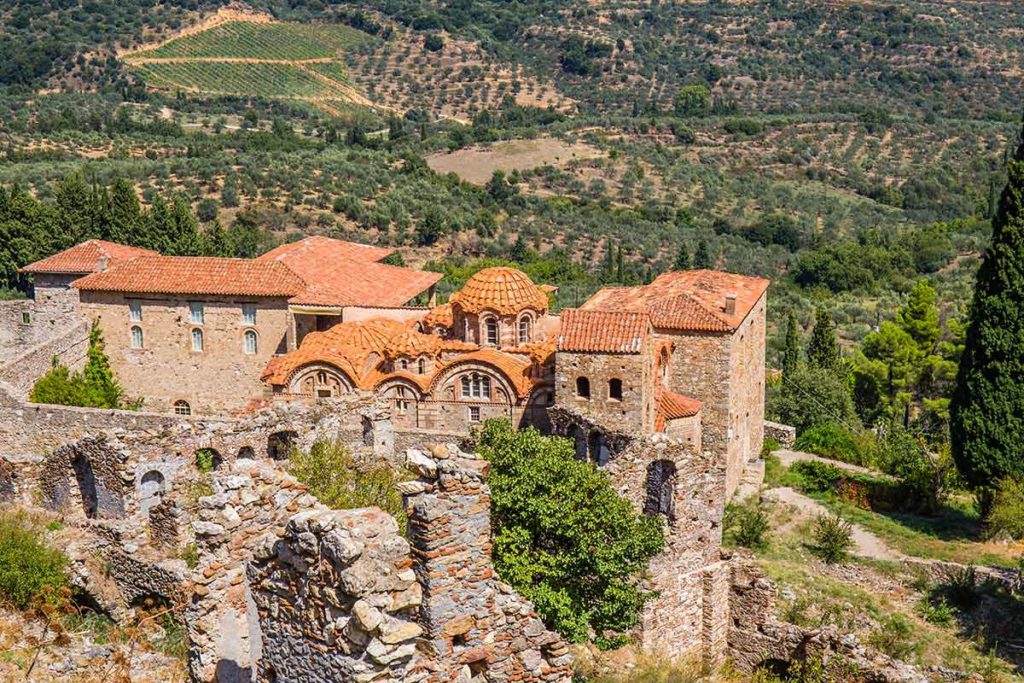
The once-bustling hillside town of Mystras was built around a 1249 fortress.
The Byzantines, Turks and Venetians conquered the city, leaving a rich cultural history.
The city was abandoned in 1832 and these days, the ruins are a mystical sight on a 620 m hill above Sparta in the southeast of the Peloponnese.
From 1262, Mystras was a Byzantine hub in southern Greece, initially as the headquarters of the military then from 1348 it became the capital of the Despotate of Morea.
Famous for it Byzantine church architecture, the palaces, convents and public squares are fascinating ruins to explore.
13- Monasteries of Meteora
The 14th-century monasteries of Meteora are some of the most famous Greek landmarks because the sight of these Medieval monasteries perched high up on soaring rock formations is fantastic.
Meteora means “suspended in the air”, and anyone who has seen them will agree with this description.
Monks built them during the 14th century and house historical treasures.
The Eastern Orthodox monks believed that the lofty locations would allow them to get closer to heaven.
Of the 24 monasteries, only six remain including the Great Meteoron Monastery (the largest) and the Monastery of the Holy Trinity (most difficult to reach).
You might recognise the latter from the James Bond movie “For your eyes only”.
The monasteries of Meteora look down upon the town of Kalambaka in Thessaly.
14- Rhodes Castle
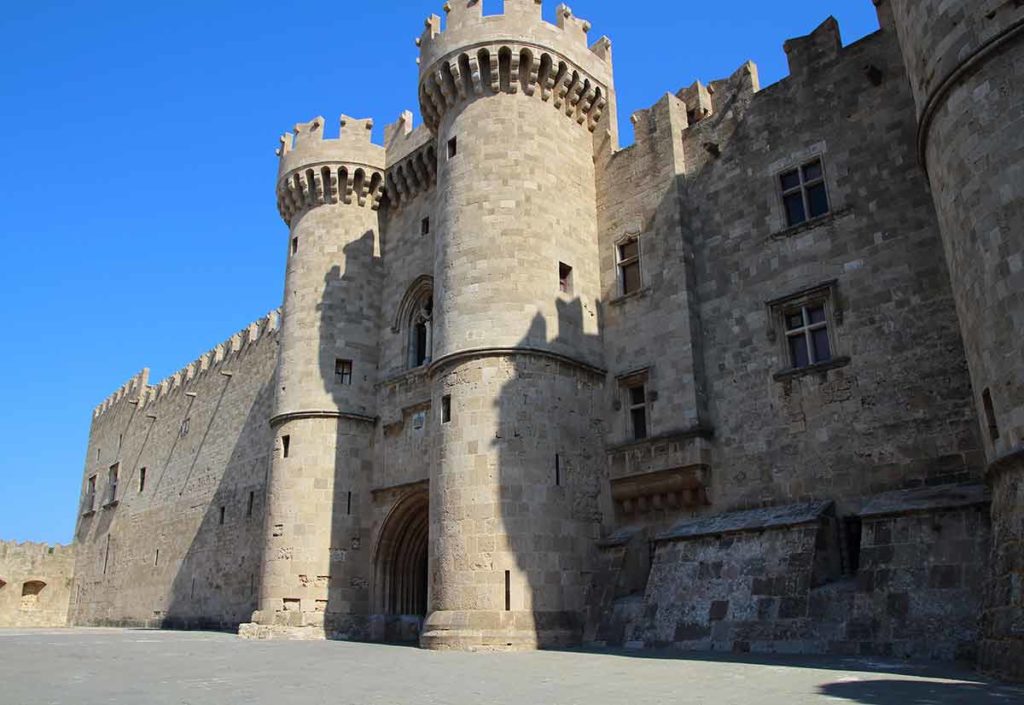
The Palace of the Grand Master of Rhodes was originally a seventh-century Byzantine citadel that was converted in a castle by the Order of Knights of the Hospital of Saint John of Jerusalem.
The order was a First Crusade monastic order with a medical mission to operate hospitals for Christian pilgrims, and members of the order were called hospitallers.
The Knights of Saint John occupied Rhodes in 1309, and members came from the Catholic states of France, Provence, Augergene, Italy, Germany, England and Spain.
They ruled the island for 200 years, with members serving as clergymen, soldiers and medics until the Ottoman Turks captured the island in 1522.
In the 1930s, this Greek landmark became a holiday residence of Benito Mussolini.
Located in the UNESCO World Heritage-listed Medieval town of old Rhodes, it’s part of a collection of historic buildings that include an Archaeological Museum that was once the Old Hospital and the Street of the Knights.
More Landmarks in Asia:
15- Bourtzi Fortress
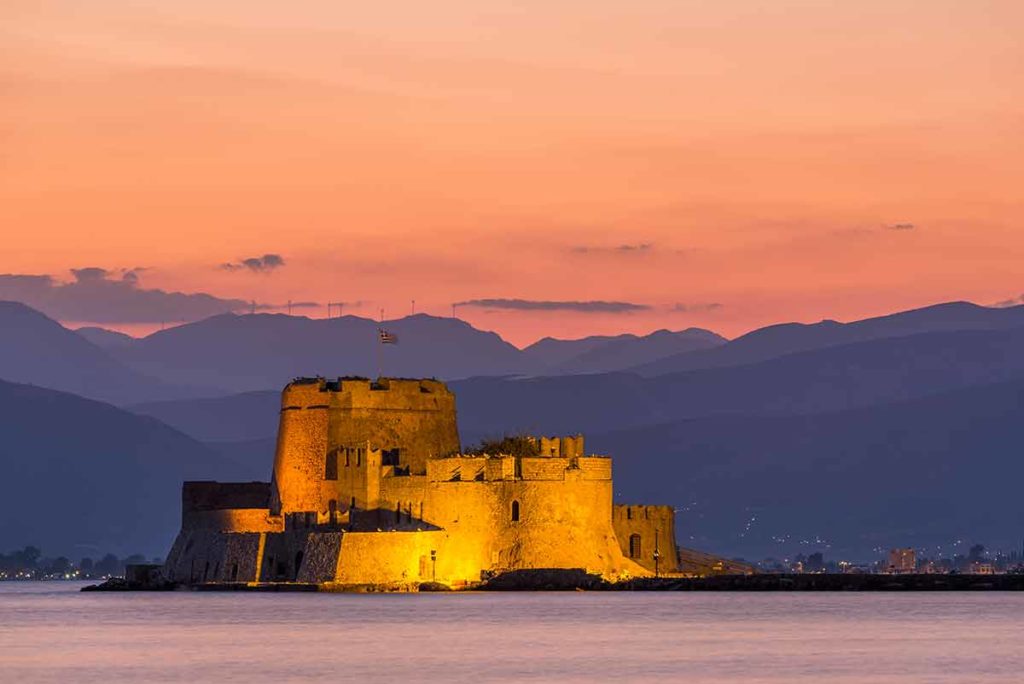
Bourtzi Fortress is in the Argolic Gulf near Nafplio.
Constructed by the Venetians in 1471 as a defence for the city, thick chains prevented enemy ships from docking.
From 1865 to 1935, Bourtzi became an executioner’s residence, and it later became a hotel.
It’s now a Greek landmark that attracts visitors who visit by boat.
It’s a venue for cultural events, but it’s currently closed for renovations.
16- Mykonos Windmills
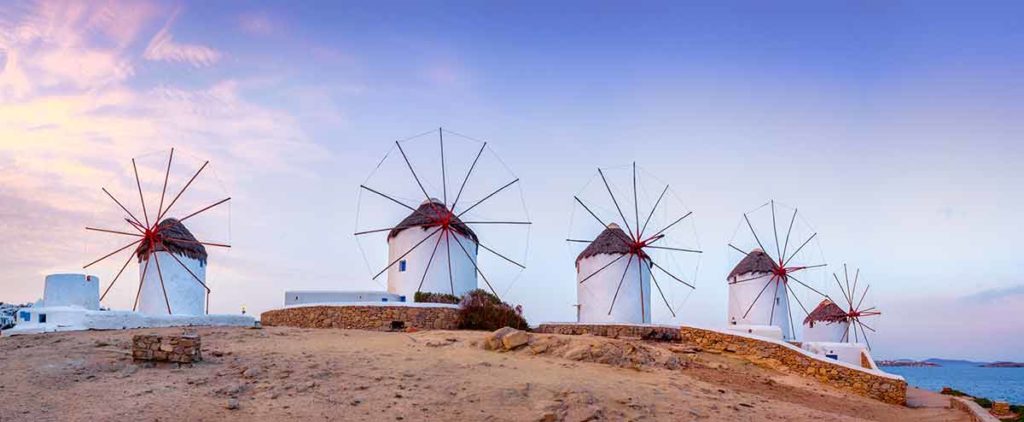
From the 16th to the 20th centuries, the Venetians built windmills on Mykonos to mill wheat.
The windmills of Mykonos are famous landmarks on the Greek island of the Mykonos, which is one of the Cyclades islands in the Aegean Sea.
Seven of the 16 remaining windmills are on a hill in the island’s main village, Chora.
Most face to the north, which has the strongest winds, and the windmills have a white oval body, conical roof and tiny windows.
The five Kato Myloi windmills have stunning views of the island, and in the main harbour, the Bonis Windmill is home to a museum about the history of the Mykonos Windmills.
The Geronymos Mill was built in the 18th-century and is the oldest windmill.
17- Old Royal Palace
100 years after it was constructed, the royal palace of King Otto and King George I became the Parliament and Senate building of the Hellenic Parliament.
The Ottoman Empire conquered Greece from 1453 to 1822, but after the fall of the Ottoman Empire, civil wars erupted in Greece among the factions.
Turkey and Egypt saw an opportunity to seize control of parts of Greece, but Russia, France and the UK sent ships to defend Greece.
The Kingdom of Greece was formed in 1832 and Otto, Prince of Bavaria and second son of Bavarian King Ludwig I, was offered the throne.
The Greek capital relocated to Athens and a royal palace built on Boubounistra Hill.
King Otto ruled for 30 years before the Greeks revolted and he was replaced by Prince William of Denmark, who became King George I of the Hellenes.
The monarchy ended in 1974 after King Constantine was driven out of Greece in 1967 by Colonel George Papadopoulos’ military coup.
Stripped of titles, palaces and passport, the royal family escaped to Rome and lived in London.
When the former king visited the old royal palace during the 2004 Olympics, all the bedrooms had been changed into office.
Greece was a republic three times.
The first republic lasted between 1822 and 1832, the second republic from 1924 to 1935 and the current republic formed in 1975.
18- Academy of Athens
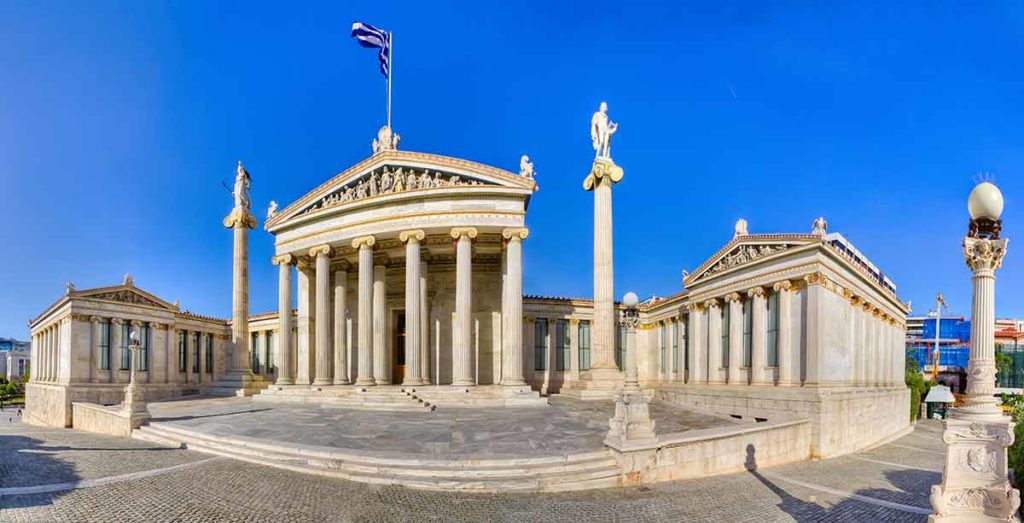
Established in 1926, Greece’s national academy is the top research establishment in the country with a charter to conduct scientific research, humanities and fine arts.
The architecturally attractive neo-classical building was designed in 1859, by the Danish architect Theophil Hansen.
Inspiration for the architecture came from fifth century BC architecture along the lines of the Acropolis.
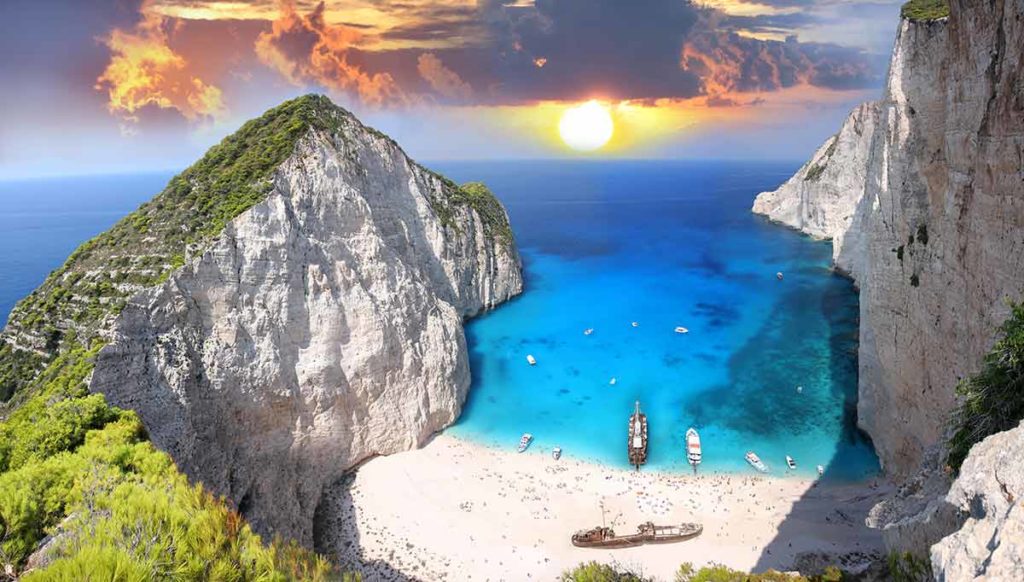
The Ionian Islands is an island group of the western coast of Central Greece and is a stunning region for a Greek Island vacation.
One of the famous landmarks in Greece is on the island of Zakynthos on Navagio Beach or Shipwreck Beach
The small white-sand bay is sheltered by a small cove where MV Panagiotis ran aground there in 1980.
The smuggler’s ship washed ashore and is a curious landmark on one of the most beautiful beaches in Zakynthos.
The islands were once ruled by the Venetians and had beautiful castles and churches.
Other islands to visit are Kefalonia, Corfu, Zante, Lefkada, Ithaca and Paxi.
You can visit Navagio Beach on a day tour by boat.
20- Monument of Alexander the Great
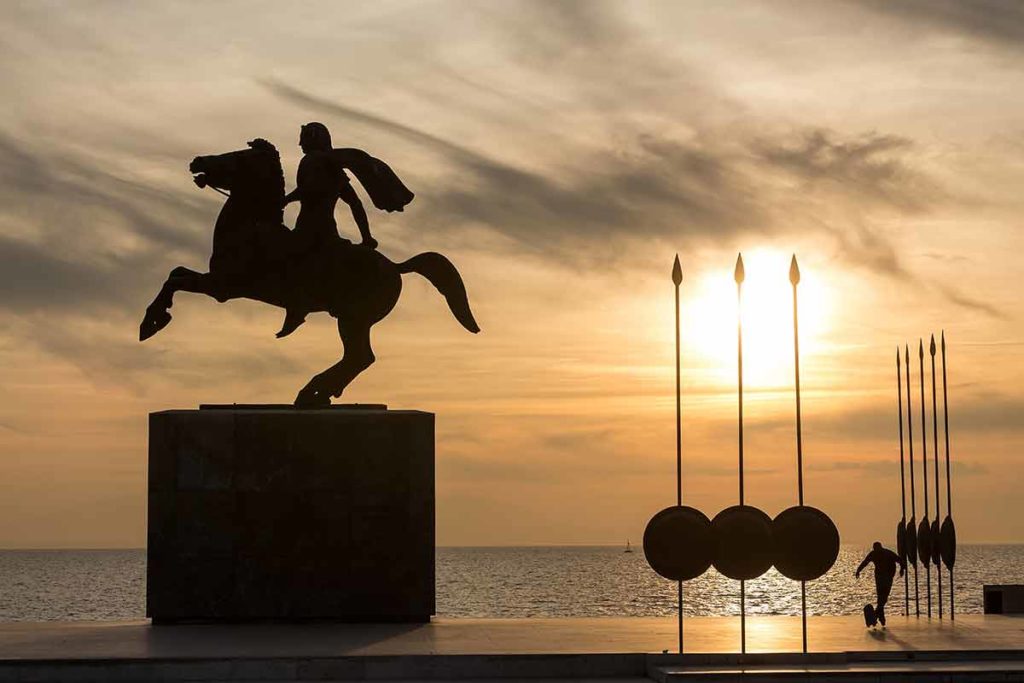
The Republic of Macedonian, a small country that was part of the former Yugoslavia, and Greece can’t agree on which country has the right to claim the history of ancient Macedonia.
There are several Alexander the Great monuments in Greece, including the one that graces the Nea Paralia waterfront in Thessaloniki, a city named after Alexander the Great’s half-sister.
The 6 m (20 ft) monument of Alexander riding his horse Bucephalus is a Greek monument that pays tribute to the son of King Phillip of Macedonia, Alexander III (born in 356 BC in Pella).
He was educated by Aristotle, who was one of the greatest philosophers of all time and became king of Macedonia in 336 BC.
Under Alexander the Great’s leadership, the ancient kingdom of Macedonia grew to become the largest empire in the world, stretching from Persia to Greece and India.
Alas, he died in Babylon in 323 BC at the young age of 32.
Thessaloniki is the second-largest Greek city and is a six-hour drive from Athens.
Also read:
- 20 Movies About Greece
- 20 Incredible Greek Landmarks
- 20 Famous Landmarks In Athens
- 20 Fairytale Castles In Greece
- When To Visit Greece
- 20 Beaches In Greece
- 20 Things To Do At Night In Athens
- 20 Day Trips From Athens
- 20 Cities In Greece You Will Love
- 20 Best Beaches in Mykonos
- A Guide To Winter In Greece
- 20 Things To Do In Mykonos
- 20 Things To Do In Rhodes
- Where To Stay In Athens
- 20 Museums in Athens
- 20 Things To Do In Santorini
- Best Greek Islands To Visit
- Car Rental Athens Tips
- Car Rental Mykonos Tips
- Where To Stay In Crete
- 20 Greece Tours For Your Bucket List
- 15 Things Greece Is Famous For
- 10-day Greece Itinerary
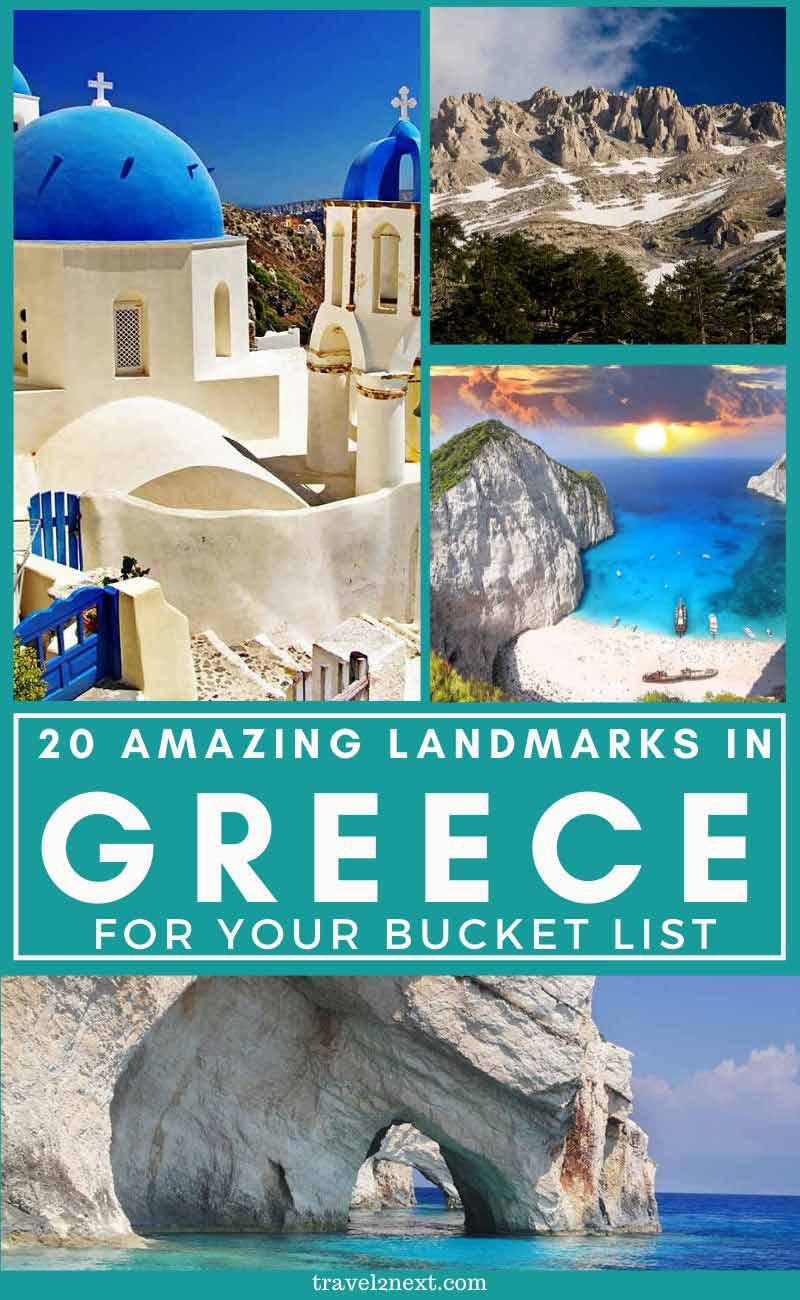
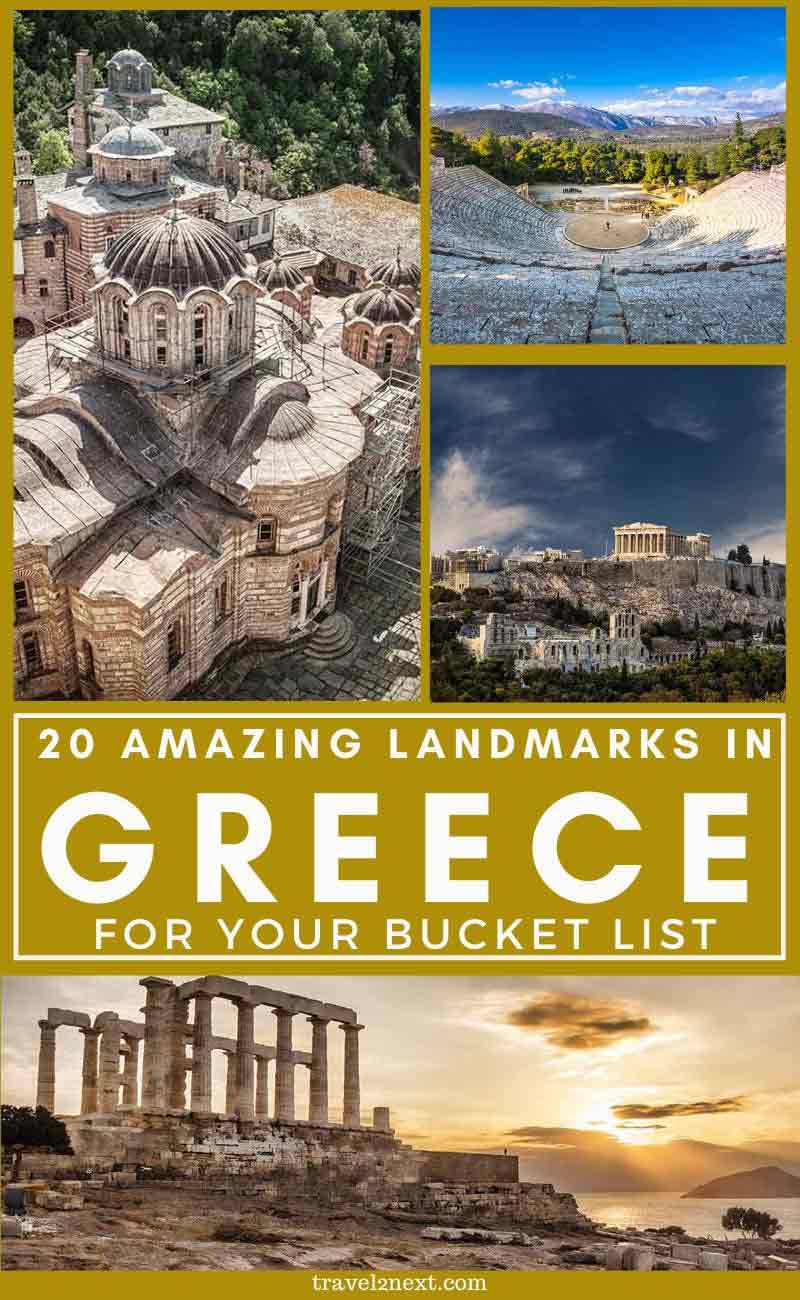
Plan Your Trip

Rent A Car – Find the best car rental rates at Discover Cars. They compare car hire companies to provide you with the best deal right now.

Find A Hotel – If you’re curious about this article and are looking for somewhere to stay, take a look at these amazing hotels.

